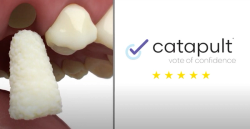- About Us
- Advertise
- Editorial
- Contact Us
- Terms and Conditions
- Privacy Policy
- Do Not Sell My Personal Information
© 2025 MJH Life Sciences™ and Dental Products Report. All rights reserved.
Step-by-Step: Stress-free partials with the VKS-SG Attachment Systems [VIDEO]
Over the years, most of the problems with any attachment are caused by poorly designed or fitting RPD (removable partial denture); specifically, frames without proper reciprocating arms.
Over the years, most of the problems with any attachment are caused by poorly designed or fitting RPD (removable partial denture); specifically, frames without proper reciprocating arms.
For this reason, we would like to recommend the following technique: The fabrication of a precision attachment RPD with custom metal housing and lingual arms, as separate components. This provides many restorative benefits for the dental technician and dentist. This technique allows technicians to fabricate highly accurate and stress-free partial frames. When using the VKS-SG system, as well as most other attachments, for fixed-removable combination cases, it is important to have an exact fitting reciprocating lingual arm and shoulder rest with an interlocking vertical groove. The main function of these is to divert occlusal loading forces away from the attachment and center them down the long axis of the tooth, also to avoid the partial slipping distally, especially on free-end saddle cases.
Important Tip
Often times after cementing the crowns, the attachment may no longer fit passively; in that case, it is very simple to use a solder iron, heat up the bonded-in metal housing, and pull it out of the major connector. After creating the space in the acrylic, it can be reset in the patient’s mouth with quick cure acrylic.
The intent of this technique is to separate the making of the attachment section from the rest of the partial. As many RPD technicians probably are able to cast a chrome-cobalt partial with attachments and have a passive-fit across the arch, in my 40 years I have not been able to do this. For many years, I split the work process and created an absolute precise attachment casting with lingual arm and in the earlier years we soldered the attachment to the chrome cobalt partial. Even with that we found that after cementing the crowns, many times there was a slight rock or movement in the attachment section. At this point I started to bond instead of solder. Bonding makes later removal and subsequent resetting of the attachment section possible. This turned out to be very beneficial for myself and the dentist as it prevented me from remaking some of those cases. A further benefit of making the attachments separate is that I make the attachment section as soon as I finish the crowns, therefore if the dentist seats the crowns right away he can then pull the attachment sections in the final impression for the partial, which gives me a very precise relationship to the crowns.
STEP BY STEP
01 In waxing the crowns, make sure the attachments are parallel and create a lingual parallel wall with a shoulder and a mesial groove.
02 Invest and cast.
03 Finish the porcelain work in a traditional manner.
04 Finish and polish the crowns.
05 Make sure your lingual arm recipient has no undercuts.
06 Place matrix on the attachment, snap on the castable housing.
07 Model on the lingual arm using a quick-cure resin, eg PiKuPlast.
08 Pull and cast the attachment section. Remove the matrix.
09 After casting, fit the casting to the crown.
10 The case should now go out to the dentist for a try-in.
11 If the dentist decides to seat the crowns at this point, have the dentist pull the attachment sections in a new master impression. Otherwise, the dentist can pull the crowns in the master impression.
12 After pouring the master model, the chrome cobalt partial is created in a traditional manner.
13 The use of pink opaquer as shown in the pictures is optional.
14 The attachment section and the chrome cobalt partials are now bonded together.
15 Teeth are set up and the partial is finished in a traditional manner.
This article originally appeared in the September 2013 issue of Dental Lab Products magazine. For more great step-by-steps, click here to subscribe: http://bit.ly/18S8j4i



